
The landmark Digital News Report published by the Reuters Institute for the Study of Journalism (RISJ) is back. The report is the most comprehensive plunge into the digital media market trends, now looking across 46 countries.
A lot has happened since the last report in 2021, which reported optimism for the news industry with the coronavirus pandemic reminding audiences of the value of trustworthy journalism. But the war in Ukraine, the lasting impact of the pandemic, concerns around the influence of big tech companies, and now the cost of living crisis have all changed the outlook.
Journalism.co.uk spoke to Nic Newman, senior research associate of RISJ, and one of the lead authors of the report and asked him to pull out ten stand-out messages from the report which paint a picture of where the digital media industry is right now. Read the full report here.
News avoidance in free fall
In the UK, nearly half of people (46 per cent) say they often or sometimes actively avoid the news, which is nearly double the figure in 2017 (24 per cent). That much is perhaps understandable with a news cycle consisting of war, a cost of living crisis and an ongoing pandemic.
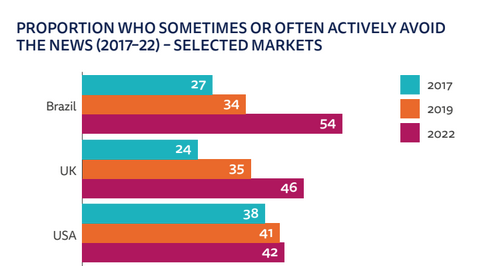
A follow-up survey in April (in response to the Ukraine war) showed that news avoidance had grown much starker in countries closer to the conflict, like Poland and Germany, whilst the UK figures remained relatively unchanged.
According to Newman, the combination of serious, complex topics and the way that the media reports them often fail to leave readers feeling informed or empowered, as well as simply having a negative effect on their mood.
"It's also that people feel powerless in the face of these huge global, complex issues, that there's nothing they can personally do about it. So for some people they just switch off as there's always something more interesting to do on your mobile phone," he notes.
"Often journalists write for other journalists or other people interested in the news, so less insider-talk and less Westminster bubble" are what is needed, says Newman.
Explainers, primers and contextualisers all seem like worthwhile content to be producing right now.
Trust in the media still struggling to recover from Brexit fallout
The UK was among the countries with the highest levels of trust in the news back in 2015 (51 per cent trusting the news most of the time) before the Brexit referendum delivered a blow to this trust.
The media is blamed as the messenger for delivering bad news, says Newman, and is a reflection of wider divisions in society, politics and culture.
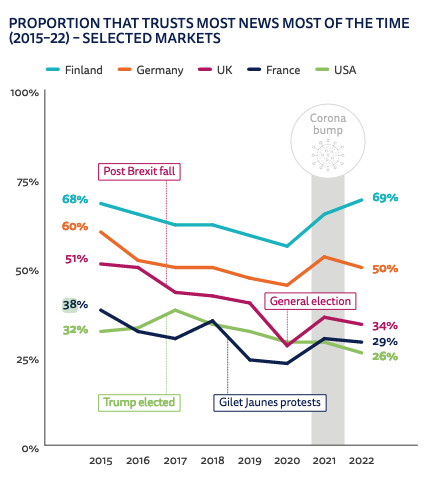
After a small 'coronabump' last year (where audiences sought out credible news about an issue that directly affected them), trust is down to 34 per cent.
The report notes that BBC News has been hit particularly hard, falling 20 percentage points in the last five years, from 75 per cent to 55 per cent. Newcomer GB News languishes at 27 per cent brand trust; The Sun trails the pack at just 12 per cent.
The media has its work cut out to win back audiences who do not trust them, and Newman says work to address this should involve trying out various engagement strategies.
Subscription diets and cost of living crisis
The war in Ukraine has brought about a new bump in subscriptions, The Telegraph counts more than 500,000 digital subscribers, followed by The Times and Sunday Times with around 400,000. The Guardian and the Financial Times both hit the 1m digital subscriber milestone recently.
However, just nine per cent of people in the UK pay for online news - up from last year's eight per cent, but distinctly behind the market average of 17 per cent and the US at 19 per cent.
And with a renewed cost of living crisis, many newsrooms fear their subscriptions are on the chopping block as readers tighten their belts. Nine per cent of subscribers say they will go on 'media subscription diets' this year.
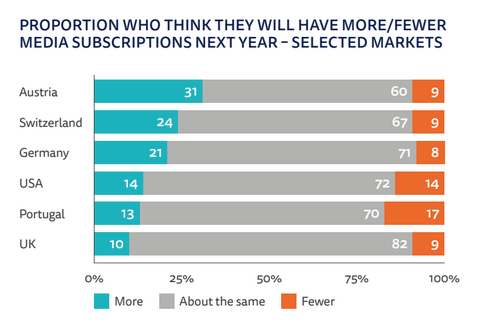
Newsrooms will have to work harder to get readers to keep their subscriptions if they take up a trial offer, and to prove their value to those who currently choose to pay.
"The key is holding onto people and keeping the average value of customers as high as possible, and then when we get into sunnier economic times, go for growth," says Newman.
"I don't think we are over-estimating the impact of the cost of living crisis, I think it's going to be a really significant problem for media companies over the next few years."
Social media winning the battle for Gen Z
Gen Z audiences are a lot more sceptical than previous generations about the news they see on their screens.
"This young generation is different; they define news differently and they are less interested in traditional subjects like politics, and they are shaped by the social aspect of news more; who is telling the story as much as what the story is itself and the conversation," says Newman.
Over a third (39 per cent) of 18-24s in the UK say social media is now their main source of news - and they are less likely to want to access news websites or apps. Newsrooms cannot assume they are known by young audiences, and they need to work harder to find and win over this audience group.
Facebook is losing its sheen, while TikTok' keeps growing both in general use and for news - 40 per cent of under-25s now use it and 15 per cent use it for news, although these are global figures and the UK is slightly behind. BBC News' apparent u-turn on launching on TikTok is a sign that news publishers cannot ignore the platform much longer, as young audiences do want credible news sources on a platform still struggling with misinformation.
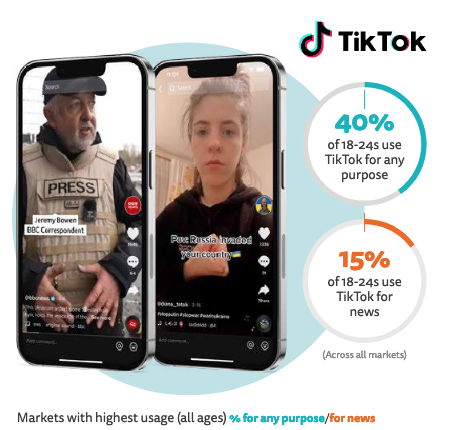
A word of caution about the rise of Substack
Newsletters have been all the rage lately, and a big reason why is the newsletter subscription provider Substack - as well as its competitors Revue and Bulletin.
However, Newman warns this is still a largely US-specific phenomenon, due to the higher rate of US consumers who subscribe to individual journalists' content (seven per cent, versus the 1 per cent in Australia and Germany).
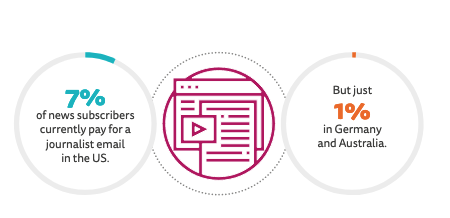
The market size of the US and its status as a Silicon Valley product means that Substack is not guaranteed to catch on elsewhere around the world to the same extent. Emails from individual journalists in the US (18 per cent) are almost five times as popular as in the UK (4 per cent) and more than twice as popular as in Germany (8 per cent).
Podcast competition heating up
Podcasting growth has returned after the pandemic eased its boom (a lack of commute might do that). In the UK, 25 per cent of respondents listened to podcasts monthly, an increase of three percentage points on the previous year.
Spotify has overtaken BBC Sounds as the UK's most-used podcast platform, at 30 per cent amongst podcast users. YouTube entering this market as a podcast discovery tool is a space to watch.
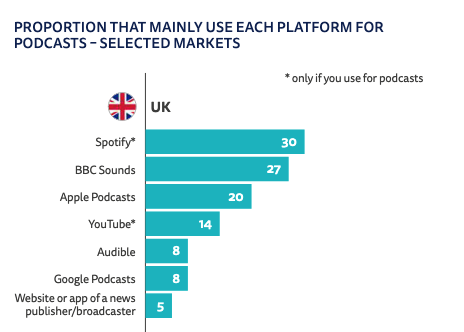
These platforms are bringing out their own subscription tiers as well, and so newsrooms need to think through their priorities when it comes to revenue, audience acquisition and data. This space is looking to become a lot more competitive.
Video is not the frontrunner
In 2022, it will be a surprise to some that video still lags behind text as the medium of choice. In the UK, 71 per cent of audiences prefer to read their news, compared with just six per cent who prefer video.
This trend is the same across most markets, although countries where video is preferred include the Philippines (26 per cent), Mexico and Peru (24 per cent).
And text is the preferred medium across all age groups - not just older audiences.
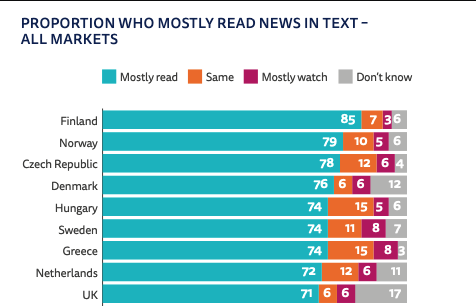
"It's slightly against the narrative that young people just watch TikTok all day, but actually the reason is they prefer the control [offered by text], it is about the speed of getting in and out quickly to access the information they want," he says.
Audiences also report finding pre-roll video ads offputting. But the growth of YouTube and TikTok also spells a new pivot to video, so there are big questions about how to find the best of both worlds, and choose the right medium for the right content.
Newman's advice? "Don't abandon text, text is your baseline. But text is also limiting. The things that people value about video are the connection and being able to see things, the emotion that comes through.
"This is the world of 'and'. It's not 'do text and not video'. It's how you provide news to a range of audiences that are appropriate and relevant with a limited set of resources."
Audiences guarded over data amid cookieless future
Google is set to phase out their third party cookies starting in 2023 and as a result, newsrooms need to start collecting their own data if they are to have a future business model.
But audiences are largely sceptical of data collection; only 16 per cent of users in the UK say they have registered for a news site (given their email address) which is one of the lowest in the survey and well below the average (28 per cent).
Willingness to share data is fundamentally rooted in trust and so transparency around the use of data is critical.
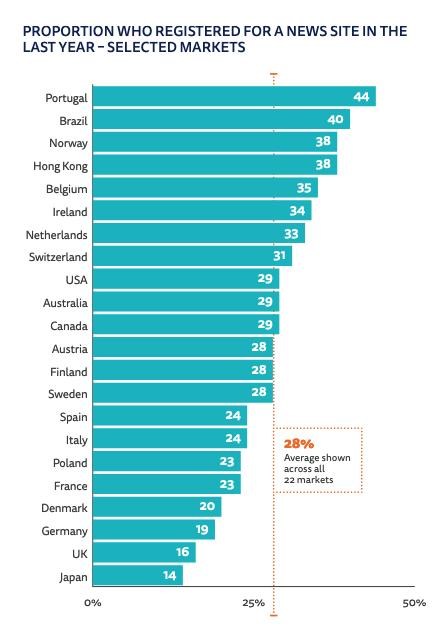
Misinformation remains a headache
The pandemic brought with it concerns around what is real or fake online, and little has happened to change that scenario: people who say they mainly use social media as a source of news are more worried (61 per cent) than people who don’t use it at all (48 per cent)
In Europe, the topic where misinformation was most widely seen was covid-19, behind politics, celebrities, climate change, immigration and products (scams).
And false information is not just spreading on the Facebooks or TikToks; there are smaller platforms where it is a growing issue and which do not have the same resources to stop it, such as Telegram.
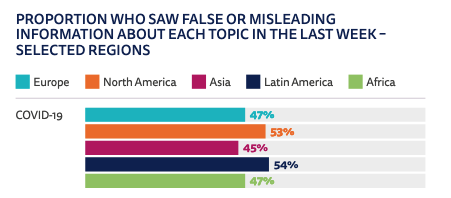
Stark generational differences on the role of journalists
Newsroom guidelines on how reporters should use social media have made headlines of late, one example being the the BBC warning staff of not playing into virtue signalling.
However, there are very clear generational differences on how journalists should conduct themselves online. The younger the news consumer, the more they tend to think journalists should be able to freely express themselves on their social media channels.
The older the news consumer, the more they tend to think they should just "stick to the facts".
As the report states: "This is just another way in which journalistic norms are being challenged by social and digital media."
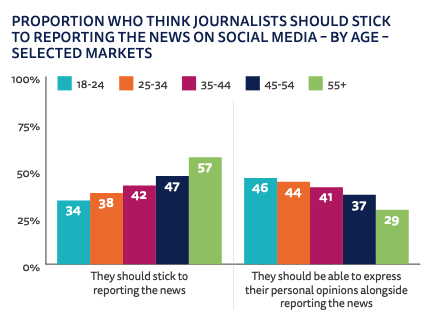
Free daily newsletter
If you like our news and feature articles, you can sign up to receive our free daily (Mon-Fri) email newsletter (mobile friendly).
Related articles
- RISJ Digital News Report 2024: User needs with Vogue and The Conversation
- RISJ Digital News Report 2024: Three essential points for your newsroom
- RISJ Digital News Report 2024: Five trends to watch in the UK
- What AI can do for your newsroom: tips from Ring Publishing's latest handbook
- How young leaders can shape the future of the media industry









